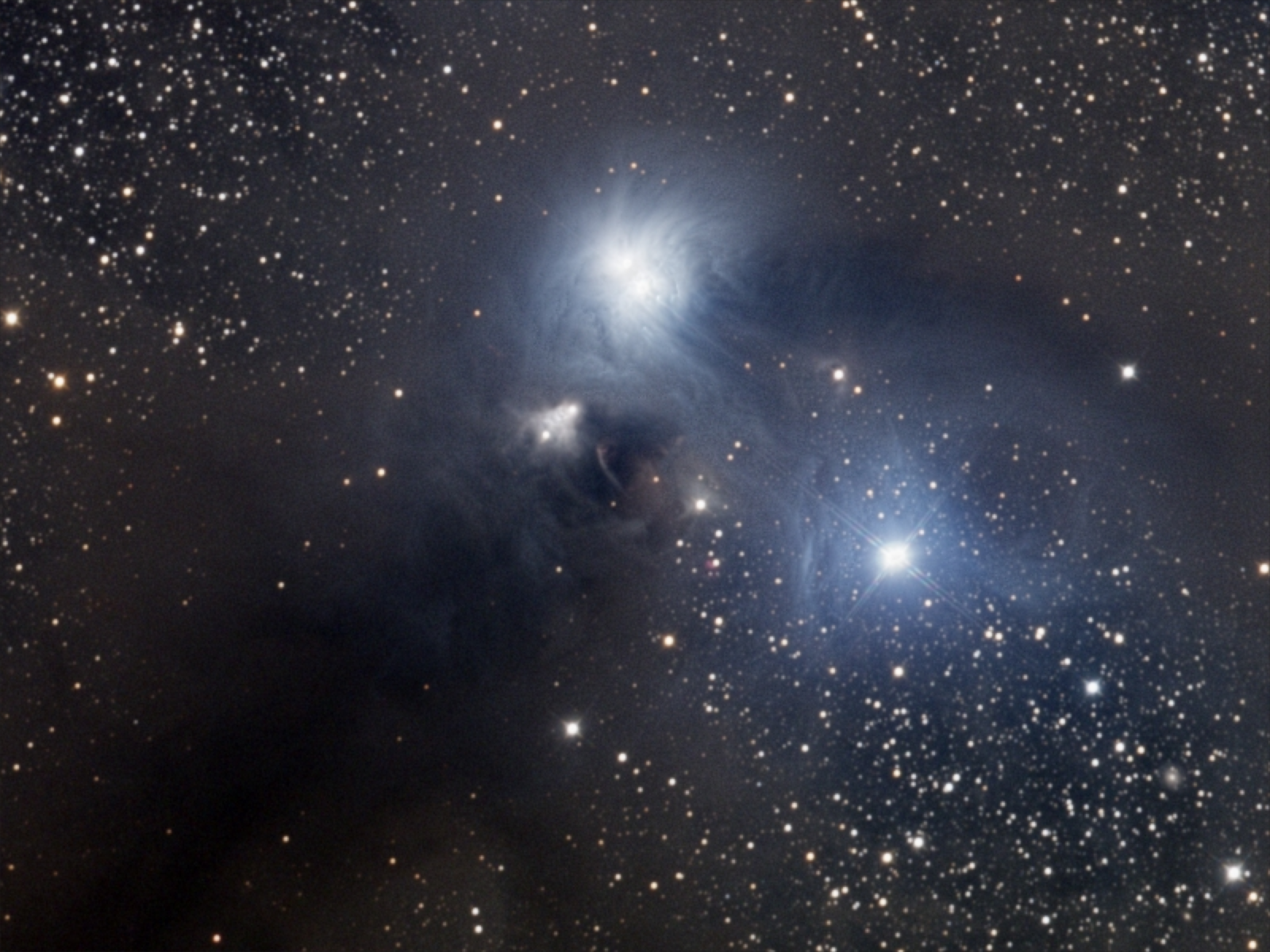Brightness variations in R CrA & NGC 6729 during 2021
2023 October 10
An indicative luminance light curve for R CrA created from data collected during 2021 showed a brightness range between magnitudes 10.6 and 13.2, when using Gaia DR2 g-band comparisons. The light curve was more consistent with the established 65.767-day period than during 2019 to 2020. Most of NGC 6729 was found to vary in brightness in a manner consistent with light echoes. Evidence for light echoes was detected 52.1 light-days, or ~9,030 astronomical units, away from R CrA. Tentative evidence for the position of the other lobe of NGC 6729 is presented.
Introduction
In recent years, the observation of variable nebulae has become increasingly popular,1 and digital technology has made it possible to derive useful quantitative results for some nebulae using relatively modest equipment.2,3 We present herein a further study of NGC 6729 that considers data collected during 2021.
The small, V-shaped nebula NGC 6729 was discovered in 1861 by Schmidt while using the 6.2-inch Plössl refractor at Athens Observatory.4 Marth later noted that the nebula and star were both variable, with the star varying over a ‘short’ timescale. This suggestion was later confirmed photographically via images captured between 1911 and 1913 by Knox-Shaw from Hêlwan Observatory,5 who surmised that there was a relationship between the magnitude of R CrA and the appearance of the nebula.6
In a recent study by the authors,7 the behaviour of NGC 6729 and the illuminating star, R CrA, was monitored using a 203mm TMB refractor similar in aperture to the instrument used by Schmidt.

NGC 6729 lies at the edge of a large, dark molecular cloud in which young stars are forming and illuminating the NGC 6726/7 nebulae. The molecular cloud extends over several degrees, but NGC 6729 is a relatively small fan-like nebula, roughly one arcminute long, illuminated by the stars R CrA at its point and T CrA near the open end of the fan. The nebula appears to be a mixture of both reflection and emission components. Within the cloud and surrounding NGC 6729 lies a cluster of infrared sources known as the Coronet Cluster,8 of which T and R CrA are the most conspicuous members.
The distance to the Coronet Cluster of young stars is 150±4 parsecs, according to a study of potential Gould Belt regions.9 This value is very similar to the figure of 150±50 parsecs for NGC 6729, determined by Gaposchkin in 1936.10 However, the star R CrA is, according to the Gaia DR2 catalogue,11 96 parsecs distant, with the early Gaia DR3 release amending that value upward to 125 parsecs.12 The discrepancy probably arises because R CrA is a triple star shrouded in bright nebulosity.
R CrA is a young star of approximately 1.5M years in age and is reported to be the closest Herbig Ae/Be star, with a spectrum dominated by emission lines.13 The previous observed variability is over a 65.767±0.007-day period and may arise from the binary nature of the star and the accretion disc.13,14
Previous observations by the authors during 2018 to 2020 demonstrated evidence that:7
– R CrA only weakly conformed with the 65.767-day variability.
– Parts of the nebulosity close to R CrA, and between it and T CrA, vary in brightness cyclically.
– The amplitude of nebulosity brightness change varies as a function of distance from R CrA.
– There is an apparent relationship between the distance from R CrA and the predicted time of R CrA maximum for some parts of the nebula.
– In some years these relationships are less obvious.
The working assumption was that the brightness changes seen across the nebula are light echoes reflected from the surface of a cone of gas and dust partially swept out by the polar winds from the young star.
We report herein the results determined for the year 2021 and compare the behaviours observed with those previously reported.
The dataset
Images of R CrA and its environs were collected by Terry Evans between March and November of 2021. The instrumentation employed to collect the data remains essentially unchanged from that described in our previous paper.7 The images were acquired using a TMB203 apochromatic refractor mounted on a Software Bisque Paramount ME4000, with the Astronomik L filtered images collected via a Starlight Xpress Trius-694 CCD camera. The system was hosted at the Riverland Dingo Observatory in South Australia.
Batches of dithered exposures of 60s duration were taken, with refocusing performed after every third frame. Flat and dark corrections were collected and applied for every dataset/night. The images were captured with NGC 6729 at elevations of between 30 and 60 degrees but, in practice, the elevation appeared to make little difference to the amount of detail apparent in the images. Images from 134 nights have been used in this study.
Blind astrometric reduction was undertaken via Astrometry.Net to ensure the results were of consistent accuracy.19 Typically, the mean resultant error was reported as ~1.2 arcseconds – slightly more than one pixel, but only one-third of the width of the typical seeing disc.
(Login or click above to view the full illustrated article in PDF format)
| The British Astronomical Association supports amateur astronomers around the UK and the rest of the world. Find out more about the BAA or join us. |
